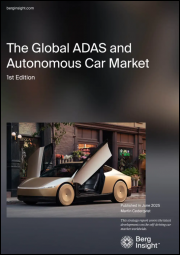
|
시장보고서
상품코드
1337769
ADAS와 자율주행의 Tier 1 조사 보고서(2023) - 해외 기업ADAS and Autonomous Driving Tier 1 Research Report, 2023 - Foreign Companies |
||||||
세계 ADAS 및 자율주행 Tier 1 공급업체는 완벽한 ADAS/AD 제품 매트릭스를 자랑하며 중국 시장을 선점하기 위해 지속적인 노력을 기울이고 있습니다.
보쉬는 CMS를 제외한 모든 ADAS/AD 제품 라인업을 갖추고 있습니다. 최신 제품으로는 CES 2023에서 실물을 전시한 1550nm의 장거리 LiDAR가 있으며, 감지 범위는 200m 이상, 소비 전력은 20W 미만입니다. 차내 모니터링 시스템(IMS, OMS)은 OMS 카메라를 센터 콘솔 화면 상단에 설치하거나 차내 룸미러와 일체형 구성으로 2024년 양산이 시작될 예정입니다.
그러나 솔루션 측면에서 볼 때, 현재 세계 Tier 1 공급업체는 중국에서 주목받는 주행 주차 통합 솔루션을 거의 출시하지 않고 있습니다. 그 중 한 가지 예는 2021년 1월에 발표된 콘티넨탈의 암바레라 CV3 기반 L2 솔루션이지만, 생산은 2026년에야 가능합니다.
현재의 수동적인 입장에 대처하기 위해 전 세계 Tier1 공급업체들도 변화를 모색하고 있습니다. 예를 들어, 보쉬의 주행 주차 통합 솔루션인 Wave3는 중국 XC 사업부와 독일 본사가 동시에 개발하고 있으며, 그 중 중국 솔루션은 듀얼 Orin SoC를 채택하여 빠르면 2023년에 양산을 시작할 예정입니다. 2023년 6월 ZF는 의사 결정 시 부서 간 내부 마찰을 줄이고 제품 및 솔루션의 시장 출시 시간을 단축하기 위해 승용차 섀시 기술과 액티브 세이프티 기술 부문의 통합을 발표했습니다. 향후 액티브 세이프티가 콕핏, 섀시 등 모든 차량 사업을 통합하는 기업 아키텍처를 구축할 가능성도 있습니다.
2023년 1월부터 5월까지 중국 신차 승용차에 탑재된 4D 레이더는 총 6만 5,500대, 그중 전방 및 후방 레이더는 3만 5,700대, 코너 레이더는 2만 9,800대이며, 4D 레이더 탑재가 확인된 모델은 라이징 오토 R7, 리오토 L7 프로, AITO M5 등입니다.
기술적 관점에서 볼 때, 현재 세계 Tier 1 공급업체가 채택한 CMS 솔루션의 주류는 CMS 카메라 2대 + OLED 디스플레이 2대, 즉 좌우 백미러를 백미러 CMS 카메라 2대(일반적으로 광각 카메라)로 대체하는 것입니다. CMS 카메라 3대 + OLED 디스플레이 2대 + 스트리밍 후방 카메라/센터 콘솔 스크린이라는 또 다른 솔루션은 이미지 스티칭/보정 등의 추가 기술이 필요하기 때문에 비교적 소수의 기업만이 채택하고 있습니다. 대표적인 사례가 Magna CLEARVIEW로, 3대의 CMS 카메라 + 스트리밍 미디어 백미러 타일형 디스플레이를 결합한 솔루션을 채택하고 있습니다. 주목할 만한 점은 Magna는 2017년에 2대의 CMS 카메라 + 2대의 OLED 디스플레이 솔루션도 제안했지만, Magna가 실제로 양산하고 있는 제품은 여전히 현재의 3CMS 솔루션입니다.
자동차 아키텍처의 업그레이드에 따라 차량 내 전자 장치의 주 제어 장치도 수백 개의 ECU에서 몇 개의 도메인 컨트롤러로 진화하고 있습니다. 다음 교차 도메인 컴퓨팅 플랫폼(예 : 콕핏-주차 통합 도메인 컨트롤러, 주행 주차 통합 도메인 컨트롤러)은 자동차의 컴퓨팅 요구를 충족시키는 데 사용됩니다. 미래에는 중앙 컴퓨팅 플랫폼이 모든 컴퓨팅 작업을 완료하고 중앙 집중식 E/E 아키텍처를 가능하게 하는 데 사용될 것입니다.
현재 여러 세계 Tier 1 공급업체들이 2022년에 멀티 도메인/중앙 컴퓨팅 플랫폼 솔루션을 출시/발표하고 있습니다. 이는 도메인 컨트롤러 제품을 대체하는 차세대 솔루션입니다.
이 보고서는 세계 ADAS 및 자율주행 Tier 1에 대해 조사했으며, 시장 개요와 함께 세계 규제, 제품 및 솔루션 개발 동향, 주요 공급업체 개요 등을 제공합니다.
목차
제1장 도로의 자율주행 적용에 관한 세계의 규제와 개발 계획
- 도로상에서의 자율주행 적용에 관한 세계의 규제
- 도로상에서의 자율주행 적용에 관한 유럽연합 및 유럽의 규제
- 도로상에서의 자율주행 적용에 관한 미국의 규제
- 도로상에서의 자율주행 적용에 관한 일본의 규제
- 도로상에서의 자율주행 적용에 관한 한국의 규제
제2장 세계의 Tier 1 공급업체 제품 및 솔루션 개발 동향
- 신제품 SOP : 4D Radars 양산 개시
- 규제 조정 : 중국은 차량의 CMS 사용을 허가
- 제품 업그레이드 : 도메인 컨트롤러에서 센트럴 컴퓨팅 플랫폼으로
- 솔루션 업그레이드 : 자율주행 주차에서 주행 주차 통합으로
- 연구개발 방향성 : 제품 매트릭스 개선과 제품 통합
제3장 주요 해외의 자율주행 Tier 1 공급업체
- Aptiv
- Bosch
- Continental
- Denso
- Hyundai Mobis
- Magna
- Valeo
- Veoneer
- ZF
Research on foreign ADAS Tier 1 suppliers: 4D radar starts volume production, and CMS becomes a new battlefield.
1. Global Tier 1 suppliers boast complete ADAS/AD product matrix, and make continuous efforts to grab the Chinese market.
From the ADAS/AD product matrix, it can be seen that some Tier 1 leaders have almost complete product matrix.
For example, Continental's latest products include: cockpit monitoring system (CMS, OMS), configured with an OMS camera and a cockpit radar and expected to be released in 2024; HRL131, a 1550nm long-range LiDAR with a detection range of more than 300m, 128° HFOV, 28° VFOV, expected to be mass-produced in 2024; and CUS320, a ultrasonic radar with a detection range of 0.1m-6m, expected to be spawned in 2024.
Bosch has a full range of ADAS/AD products except CMS. Its latest products include: a 1550nm long-range LiDAR, physically displayed at the CES 2023, with a detection range of over 200m and power consumption of less than 20W; an in-cabin monitoring system (IMS, OMS), configured with an OMS camera installed above the center console screen or integrated with the interior rearview mirror, and expected to come into mass production in 2024.
Yet in terms of solutions, currently few global Tier 1 suppliers deploy driving-parking integrated solutions that are hot in China, mainly because it takes them a period of about 2 or 3 years to launch the solutions after they put forward. One example is Continental's Ambarella CV3-based L2+ solution which was announced in January 2021 but will not be production-ready until 2026.
To cope with the current passive position, global Tier 1 suppliers are also trying to seek changes. For example, Wave3, Bosch's driving-parking integrated solution, is being developed simultaneously by the XC Division in China and the headquarters in Germany, of which the Chinese solution adopts dual Orin SoCs and is scheduled to be mass-produced in 2023 at the earliest; in June 2023, ZF announced the merger of the divisions for passenger car chassis technology and active safety technology to reduce the internal friction between divisions when making decisions and shorten the time-to-market of products and solutions. In the future, ZF may build a corporate architecture where the active safety integrates all the vehicle businesses such as cockpit and chassis.
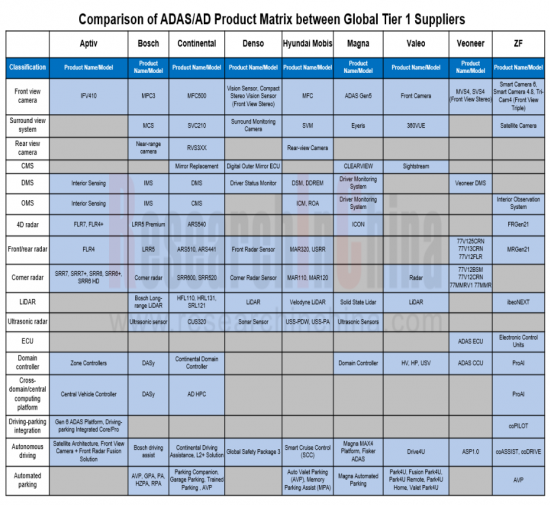
2. 4D radars begin to find mass adoption, and global Tier 1 suppliers grab first-mover advantages.
According to our data, from January to May 2023, the overall installations of 4D radars in new passenger cars in China were 65,500 units, of which 35,700 units were front view and rear view radars, and 29,800 units were corner radars. Models confirmed to pack 4D radars include Rising Auto R7, Li Auto L7 Pro and AITO M5.
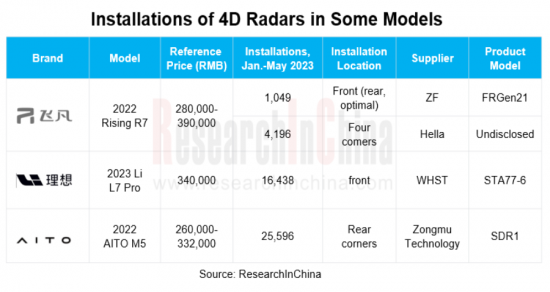
4D radars have passed through three development phases: infancy, growth and SOP.
- Infancy: before 2022, foreign Tier 1 suppliers were the first to start upgrading from conventional 3D radar to 4D radar, for example, Continental went about developing ARS540 early in 2016.
- Growth: during 2022-2024, Chinese suppliers set about deploying 4D radar products. For example, in 2022 Nova Electronics introduced 4D-S front radar and corner radar products, as well as a new 6-cascade product; Freetech released FVR40 in 2022.
- SOP: beyond 2024, it is expected that 4D radars will begin to be spawned and mounted on vehicles.
Currently, 4D radars are still in the verification phase, and whether the installations will rise depends on the following:
- (1) Verify the cost performance of 4D radars (replacing ordinary radars) used in low-level driving assistance solutions (L2-L2+). Examples include Aptiv's satellite architecture-based sensing and computing system that supports L2 and L2+ with 5R5V12U.
- (2) Verify the feasibility of 4D radars replacing LiDAR in high-level intelligent driving solutions (L2.5-L2.9, that is, supporting ADAS in highway NOA and city NOA).
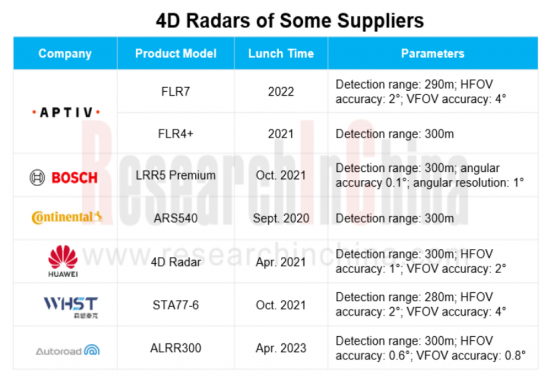
3. China's adjusted regulation allows CMS to be installed in vehicles, and the competition in the new market is fierce.
On July 1, 2023, the GB 15084-2022 Motor Vehicles - Devices for Indirect Vision - Requirements of Performance and Installation came into effect, specifying that Class M/N motor vehicles are allowed to carry electronic rearview mirrors to replace conventional optical exterior rearview mirrors.
At present, a number of global Tier 1 suppliers, Chinese suppliers and automakers have already made layout of CMS products. Wherein, the global Tier 1 suppliers that have unveiled/mass-produced CMS products include Continental, Magna and Valeo; Chinese suppliers include Autocruis, Voyager Technology, Foryou Group and Huawei.
On the whole, global Tier 1 suppliers start CMS layout a little earlier than Chinese companies, due to early introduction of regulations.
From a technical point of view, the mainstream CMS solution currently adopted by global Tier 1 suppliers is 2 CMS cameras + 2 OLED displays, that is, replace the left and right rearview mirrors with 2 rearview CMS cameras (generally wide-angle cameras). Another solution of 3 CMS cameras + 2 OLED displays + streaming rearview camera/center console screen is adopted by relatively few companies, as it involves additional technologies such as image stitching/correction. A typical case is Magna CLEARVIEW that adopts the solution of 3 CMS cameras + streaming media rearview mirror tiled display. Noticeably, Magna also proposed a solution of 2 CMS cameras + 2 OLED displays in 2017, but the product Magna actually produces in quantities is still the current 3CMS solution.
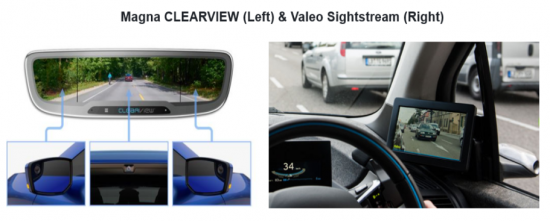
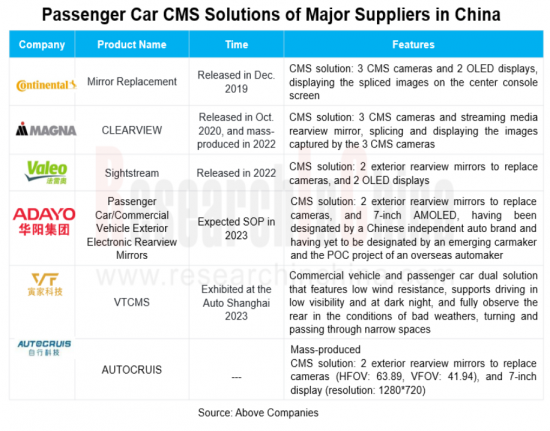
4. As decision products upgrade, a number of Tier 1 suppliers have launched cross-domain/central computing platforms.
As automotive architecture upgrades, the main control units of vehicle internal electronics have also evolved from hundreds of ECUs to several domain controllers. Next cross-domain computing platforms (e.g., cockpit-parking integrated domain controller and driving-parking integrated domain controller) will be used to meet the computing needs of vehicles. In the future, central computing platforms will be used to complete all the computing tasks and enable centralized E/E architecture.
In current stage, several global Tier 1 suppliers have released/iterated multi-domain/central computing platform solutions in 2022. In terms of time node, they are the next-generation alternative to domain controller products.
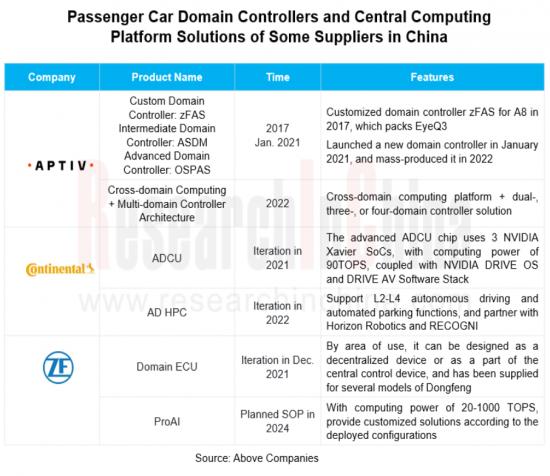
The early solutions include ZF ProAI, which has gone through several iterations, with the computing power increased from 1-10 TOPS to the current 20-1500 TOPS. The latest version of ProAI, scheduled to start volume production in 2024, enables cross-domain computing, packs ZF's domain control middleware, and is optimized for deep learning. Aptiv, on the other hand, puts forward three solutions based on a cross-domain computing platform: a cross-domain computing platform + dual domain controllers, a cross-domain computing platform + three domain controllers, and a cross-domain computing platform + four domain controllers.
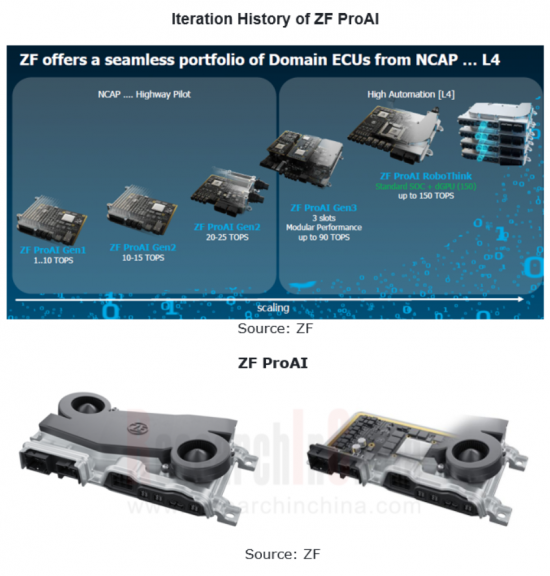
Table of Contents
1 Global Regulations on Application of Autonomous Driving on Roads and Development Plans
- 1.1 Global Regulations on Application of Autonomous Driving on Roads
- 1.1.1 UN Automated Lane Keeping Systems (ALKS) - Main Test Items
- 1.1.1 UN Automated Lane Keeping Systems (ALKS) - System Safety and Failsafe Response
- 1.1.1 UN Automated Lane Keeping Systems (ALKS) - Human Machine Interface (HMI) / Operator information
- 1.1.1 UN Automated Lane Keeping Systems (ALKS) - Object Event Detection and Data Storage
- 1.1.2 Summary on Autonomous Driving Development Plans of Some Countries/Regions
- 1.2 European Union & Europe's Regulations on Application of Autonomous Driving on Roads
- 1.2.1 Germany's Law on Autonomous Driving
- 1.2.2 EU & Europe's Autonomous Driving Development Plan
- 1.2.3 EU Autonomous Driving Roadmap and 2040 Outlook
- 1.3 United Sates' Regulations on Application of Autonomous Driving on Roads
- 1.3.1 US Autonomous Driving Development Plan
- 1.4 Japan's Regulations on Application of Autonomous Driving on Roads
- 1.4.1 Japan's Action Plan for Realizing and Popularizing Autonomous Driving 4.0
- 1.4.2 Japan's Autonomous Driving Development Plan
- 1.4.3 Japan's "RoAD to the L4 Project" - 4 Major Themes
- 1.5 South Korea's Regulations on Application of Autonomous Driving on Roads
- 1.5.1 South Korea's Autonomous Driving Development Plan
2 Development Trends of Products and Solutions of Global Tier 1 Suppliers
- 2.1 SOP of New Products: the Volume Production of 4D Radars Starts
- 2.2 Regulation Adjustment: China Allows for Use of CMS in Vehicles
- 2.3 Product Upgrade: from Domain Controller to Central Computing Platform
- 2.4 Solution Upgrade: from Automated Driving/Parking to Driving-parking Integration
- 2.5 R&D Direction: Product Matrix Improvement + Product Iteration
3 Key Foreign Autonomous Driving Tier 1 Suppliers
- 3.1 Aptiv
- 3.1.1 Profile
- 3.1.2 Revenue
- 3.1.3 Competitors/Main Customers
- 3.1.4 Product Classification
- 3.1.5 Perception Products - Front View Camera
- 3.1.6 Perception Products - 4D Front Radar
- 3.1.7 Perception Products - Corner Radar
- 3.1.8 Decision Products - Domain Controller/Central Computing Platform
- 3.1.9 Solutions - Driving-parking Integration
- 3.1.10 Solutions - Autonomous Driving
- 3.1.11 Autonomous Driving Layout
- 3.1.12 Product/Market Planning
- 3.1.13 Summary
- 3.2 Bosch
- 3.2.1 Profile
- 3.2.2 Revenue
- 3.2.3 Product Classification
- 3.2.4 Perception Products - Front View Camera
- 3.2.5 Perception Products - Surround View System
- 3.2.6 Perception Products - 4D Front Radar
- 3.2.7 Perception Products - Front Radar
- 3.2.8 Perception Products - Corner Radar
- 3.2.9 Perception Products - LiDAR
- 3.2.10 Perception Products - DMS/OMS
- 3.2.11 Perception Products - Ultrasonic Radar
- 3.2.12 Decision Products - Domain Controller
- 3.2.13 Middleware
- 3.2.14 Solutions - Autonomous Driving
- 3.2.15 Solutions - Automated Parking
- 3.2.16 Recent Development Layout/Planning
- 3.2.17 Autonomous Driving Partners
- 3.2.18 Summary
- 3.3 Continental
- 3.3.1 Profile
- 3.3.2 Revenue
- 3.3.3 Product Classification
- 3.3.4 Perception Products - Front View Camera
- 3.3.5 Perception Products - Rear View Camera
- 3.3.6 Perception Products - Surround View System
- 3.3.7 Perception Products - CMS
- 3.3.8 Perception Products - DMS
- 3.3.9 Perception Products- OMS
- 3.3.10 Perception Products - Front Radar
- 3.3.11 Perception Products - Corner Radar
- 3.3.12 Perception Products - LiDAR
- 3.3.13 Perception Products - Ultrasonic Radar
- 3.3.14 Decision Products - Domain Controller
- 3.3.15 Decision Products - Central Computing Platform
- 3.3.16 Solutions - Autonomous Driving
- 3.3.17 Solutions - Automated Parking
- 3.3.18 Solutions - Road Data Solution
- 3.3.19 Engineering Solutions
- 3.3.20 Robotaxi
- 3.3.21 Autonomous Driving Roadmap
- 3.3.22 Continental China's Autonomous Driving Planning
- 3.3.23 Autonomous Driving Technologies
- 3.3.24 Summary
- 3.4 Denso
- 3.4.1 Profile
- 3.4.2 Revenue
- 3.4.3 Product Classification
- 3.4.4 Perception Products - Front View Camera
- 3.4.5 Perception Products - Surround View System
- 3.4.6 Perception Products - Front Radar
- 3.4.7 Perception Products - LiDAR
- 3.4.8 Perception Products - Ultrasonic Radar
- 3.4.9 Solutions - ADAS
- 3.4.10 Solutions - Autonomous Driving
- 3.4.11 Autonomous Driving Development Roadmap
- 3.4.12 Autonomous Driving Capabilities and R&D Layout
- 3.4.13 Summary
- 3.5 Hyundai Mobis
- 3.5.1 Profile
- 3.5.2 Revenue
- 3.5.3 Perception Products - Front View Camera
- 3.5.4 Perception Products - Surround View System
- 3.5.5 Perception Products - DMS
- 3.5.6 Perception Products - Radar
- 3.5.7 Perception Products - LiDAR & Ultrasonic Radar
- 3.5.8 Solutions - Automated Parking
- 3.5.9 Solutions - Autonomous Driving
- 3.5.10 Autonomous Concept Car
- 3.5.11 Autonomous Driving Development Planning
- 3.5.12 Summary
- 3.6 Magna
- 3.6.1 Profile
- 3.6.2 Revenue
- 3.6.3 Product Classification
- 3.6.4 Perception Products - Front View Camera
- 3.6.5 Perception Products - Surround View System
- 3.6.6 Perception Products - CMS
- 3.6.7 Perception Products - DMS/OMS
- 3.6.8 Perception Products - 4D Front/Corner Radar
- 3.6.9 Perception Products - LiDAR & Ultrasonic Radar
- 3.6.10 Decision Products - Domain Controller
- 3.6.11 Solutions - Autonomous Driving
- 3.6.12 Solutions - Automated Parking
- 3.6.13 Autonomous Driving & Intelligent Connectivity Planning
- 3.6.14 Summary
- 3.7 Valeo
- 3.7.1 Profile
- 3.7.2 Revenue
- 3.7.3 Autonomous Driving Product Layout
- 3.7.4 Automotive Product Layout
- 3.7.5 Distribution of R&D Bases in China
- 3.7.6 Autonomous Driving Products - Front View Camera
- 3.7.7 Autonomous Driving Products - Surround View System
- 3.7.8 Autonomous Driving Products - CMS
- 3.7.9 Autonomous Driving Products - Radar
- 3.7.10 Autonomous Driving Products - LiDAR
- 3.7.11 Autonomous Driving Products - Domain Controller
- 3.7.12 Autonomous Driving Products - Ultrasonic Radar
- 3.7.13 Solutions - Automated Parking
- 3.7.14 Solutions - Autonomous Driving
- 3.7.15 Autonomous Delivery Vehicles
- 3.7.16 Intent Prediction Technology
- 3.7.17 360-degree Autonomous Emergency Braking System
- 3.7.18 Autonomous Driving Product Partners
- 3.7.19 Summary
- 3.8 Veoneer
- 3.8.1 Profile
- 3.8.2 Revenue
- 3.8.3 Corporate Development Roadmap
- 3.8.4 Autonomous Driving Product Layout
- 3.8.5 Summary on Autonomous Driving Products
- 3.8.6 Perception Products - Camera
- 3.8.7 Perception Products - DMS
- 3.8.8 Perception Products - Radar
- 3.8.9 Perception Products - LiDAR
- 3.8.10 Decision Products - Domain Controller
- 3.8.11 Autonomous Driving Products - Positioning System
- 3.8.12 Autonomous Driving Products - V2X
- 3.8.13 Solutions - Autonomous Driving
- 3.8.14 Development History and Planning of Autonomous Driving Solutions
- 3.8.15 Main Partners
- 3.8.16 ADAS Technology Releases, 2021
- 3.8.17 Application of ADAS Products in Vehicles, 2021
- 3.8.18 Distribution of ADAS Product Customers, 2021
- 3.8.19 Summary
- 3.9 ZF
- 3.9.1 Profile
- 3.9.2 Recent Changes in Business Division Structure
- 3.9.3 Revenue
- 3.9.4 Product Classification
- 3.9.5 Perception Products - Front View Camera
- 3.9.6 Perception Products - Surround View System
- 3.9.7 Perception Products - OMS
- 3.9.8 Perception Products - 4D Front Radar
- 3.9.9 Perception Products - Front Radar
- 3.9.10 Perception Products - LiDAR & Sound Sensor
- 3.9.11 Decision Products - Vehicle Computing Platform
- 3.9.12 Decision Products - Domain Controller & Middleware
- 3.9.13 Solutions - Autonomous Driving & Driving-parking Integration
- 3.9.14 Solutions - Automated Parking
- 3.9.15 Development Trends & Layout
- 3.9.16 Summary






